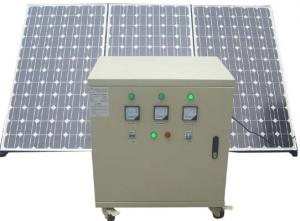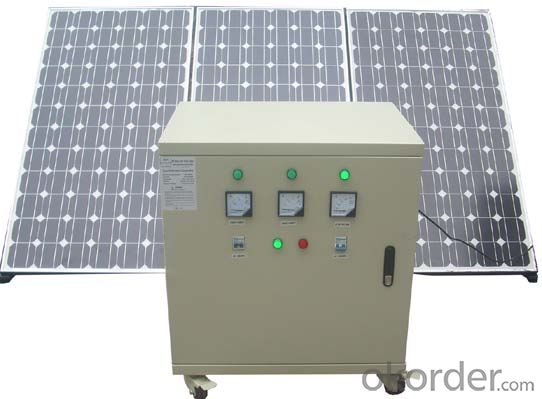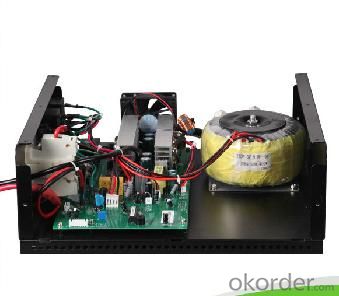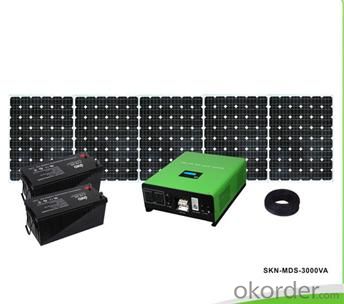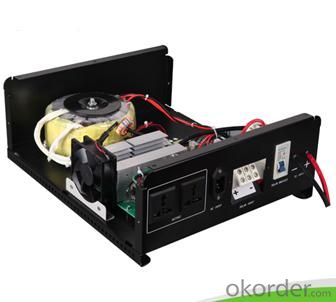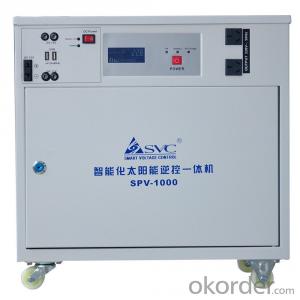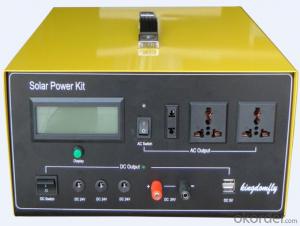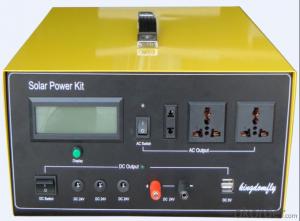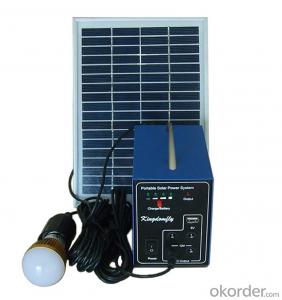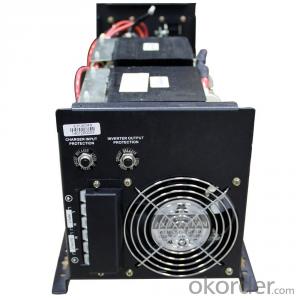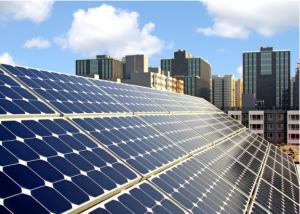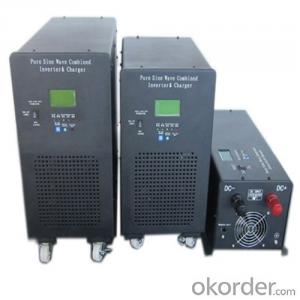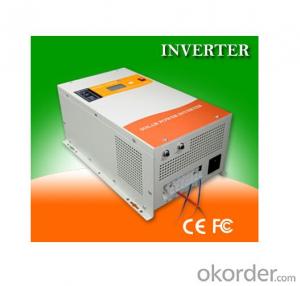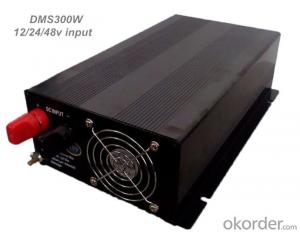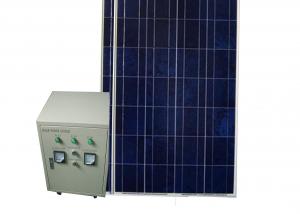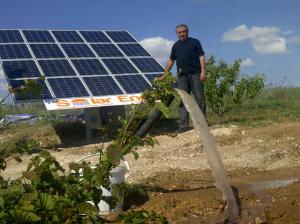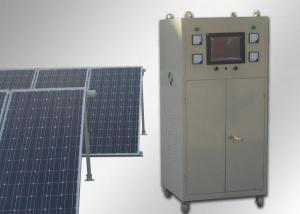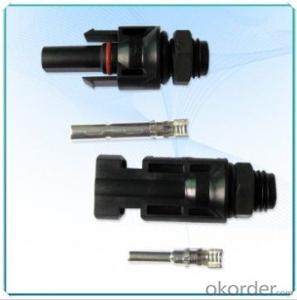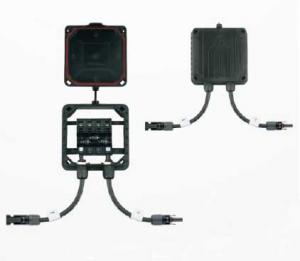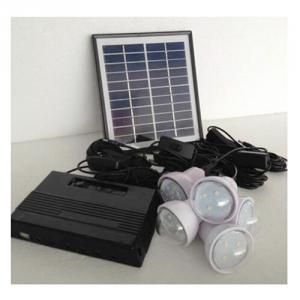Solar Energy Systems Keswick Pure Sine Wave Solar System SKN-MDS 1000VA-3000VA
- Loading Port:
- Shanghai
- Payment Terms:
- TT or LC
- Min Order Qty:
- 300 watt
- Supply Capability:
- 200000 watt/month
OKorder Service Pledge
OKorder Financial Service
You Might Also Like
Quick Details
| Specification: | Normal | Application: | Home | Output Voltage (V): | 110V or 220V |
| Load Power (W): | 800W-2400W | Solar Power (W): | 100W-3000W | Work Time (h): | as long as it works |
| Solar Panel: | Polycrystalline | Battery: | With Battry Together | form wave: | pure sine wave |
| transfer time: | less than 10ms | Inverter: | DC to AC | Solar Inverter: | Inverter With Controller Inside |
| DC: | 12V-48V | model: | from 1KVA-3KVA | pure sine wave: | yes |
| Packaging & Delivery | |
| Packaging Detail: | carton |
| Delivery Detail: | 1*20FT container within one month |
| Specifications | |
| inverter,controller building in one case | |
| pure sine wave inverter | |
| AC charger optional | |
| LED or LCD display | |
| 110V or 220V | |
Specifications
Pure Sine Wave Solar Inverter
>Solar Charge Controller Inside
>AC Charger Inside
>LED LCD Display
>Wall Mount Design CE ISO
Features:
1.Environmental protection
2.Energy-saving products
3.Portable
4.easily use
Advantages:
1.Safety and easy installation,Plug and play systems;
2.Good quality panel to ensure the high efficiency and long life needs;
3.Solar Automatic lighting controller :with adjustable run times, over-current protection;
4.Solar Batteries: Maintenance free, long life batteries
5.Lighting Source: LED lamp /Lantern (Fixed/Movable)
7.Flexible designs per client requests;
Using of scope:
It is very good for indoor use where there is shortage of electricity and for outdoor activities such as picnicking, fishing and camping. It is an ideal tool for Motor Mechanics, Farm House and small shop owners such as Hairdressers, Barbers, Cobblers, Tailors and Kiosk keepers.
Pure Sine Wave Solar Inverter SKN-MDS 1000VA To 3000VA For Home
1.Power Range: 1000VA 2000VA,3000VA
2.Power Factor: 0.8
3.DC Voltage: 12V,24V,48V
4.Include AC Charger Function Inside
5.The SKN-MDS Inverter Include Solar Charge Controller Inside
6.Pure Sine Wave Inverter SKN-MDS With AVR Function
7.Inverter With AC Charger With Solar Charge Controller With AVR All In One
8.22 Year Brand Quality Garantee
9.High End Inverter Design With Wall Mount Design
10.Popular Design With LED LCD Display
Pure Sine Wave Solar Inverter SKN-MDS Main Function Features
> Micro Processor Control
> Pure Sine Wave
> With AC Charger
> Intelligent Automatic Voltage Regulating Technology
> Intelligent Automatic Voltage Charging Technology
> Over Load, Short Circuit Protection
> Over Temperature Protection
> By Pass System
> Automatic Charge Even Inverter Is Off
> Shut Off Output By Manual If No Need Power
> Low Battery Protection
> Over Voltage, Low Voltage Protection
> With Polarity Protection
> Compatibility With Generators
> The LED&LCD Display Design Option
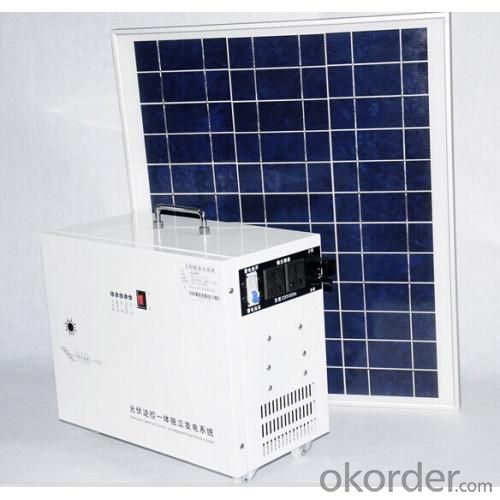
| SKN-MDS 800W SERIES TECHNICAL PARAMETER | |||
| SKN-MDS-3000-800W | |||
| Name Of Parts | Specifications | Parameters | Quantity (PCS) |
| Mono-Crystalline Solar Panels | The Maximum Power Of Solar Panels (W) | 200W | 4PCS |
| The Short Circuit Current Of Solar Panels (A) | 8.24A | ||
| The Maximum Power Current Of Solar Panels (A) | 7.51A | ||
| The Open Circuit Voltage Of Solar Panels (VDC) | 32.73VDC | ||
| The Maxium Power Voltage Of Solar Panels (VDC) | 36VDC | ||
| Battery | Maintenance Free Lead-Acid Battery | 12V/150AH | 4PCS |
| Solar Charge Controller | Rated Voltage (VDC) | 48VDC | 1PCS |
| Discharge Current (A) | 60A | ||
| Charge And Recover Voltage (VDC) | 53.2V/Lead-Acid | ||
| The Battery'S Overvoltage Protection And Recovery | 57.6V/52.8VDC | ||
| The Set Range Of Voltage When Low Voltage Off | 43.2V-46.4VDC | ||
| The Set Range Of Voltage When Low Voltage On | 48.4V-52.8VDC | ||
| Inverter | Rated Output Power (W) | 2400W | 1PCS |
| Rated Output Voltage (VAC) | 220VAC±10%, 50Hz±2Hz | ||
| Output Waveform | Pure Sine Wave | ||
| Rated Input Voltage (VDC) | 48VDC | ||
| Undervoltage Alarm (VDC) | 42±0.5VDC | ||
| Low Voltage Off (VDC) | ≤ 40.0VDC | ||
| Overvoltage Off (VDC) | ≥ 56.8VDC | ||
| Efficicency | ≥ 90% | ||
| Output | AC 220V Terminal | 220V / 10A | 1PCS |
| AC 220V Socket | 220V / 1A | 2PCS | |
| Accessories | Solar Panel Wire | 10M | 1PCS |
| Utility Power Charge Wire | 1.5M | 1PCS | |
| Portable Box Dimension (mm) | Box:470*424*244 mm, Package: 550*504*330 mm | ||
| Solar Panel Dimension (mm) | 1482*992*40 mm *4PCS | ||
| Battery Dimension (mm) | 485*172*240mm *4PCS | ||
| Weight (KG) | Box G.W.: 30Kg, Solar Panel: 17Kg*4PCS Battery: 44.5Kg*4PCS | ||
| DISCHARGE TIME (HOURS) | |||
| Item | Specifications | Quantity (PCS) | Lighting Time (Hours) |
| LED Lights | 3W | 1 | 1120 |
| Electric Fan | DC 12V/30W | 1 | 112 |
| TV | AC220V (LCD 32Inch 60W) | 1 | 56 |
| Fridge | AC220V 120W | 1 | 28 |
| Computer | AC220V 200W | 1 | 17 |
- Q: Can solar energy systems be used for heating and cooling?
- Yes, solar energy systems can be used for heating and cooling. Solar thermal systems can collect and store heat from the sun to provide hot water and space heating. Additionally, solar-powered air conditioning systems are also available, using solar energy to cool buildings.
- Q: Can a solar energy system be used in areas prone to earthquakes?
- Yes, a solar energy system can be used in areas prone to earthquakes. Solar panels are typically designed to withstand various weather conditions, including earthquakes. They are built to meet specific structural standards and are tested for durability. Additionally, solar energy systems do not rely on any intricate moving parts, making them less vulnerable to damage during seismic activities. However, it is important to ensure proper installation and adhere to local building codes to enhance their resilience in earthquake-prone areas.
- Q: What is the role of voltage regulators in a solar energy system?
- The function of voltage regulators within a solar energy system is to guarantee that the voltage output of the solar panels remains regulated and maintained within a specific range. Solar panels produce direct current (DC) electricity, which must be converted to alternating current (AC) in order to be utilized in homes and businesses. Nevertheless, the voltage output of solar panels can fluctuate due to varying factors such as sunlight intensity, temperature, and system load. Voltage regulators, also referred to as charge controllers, are responsible for stabilizing the voltage output of the solar panels. They constantly monitor the voltage level and make necessary adjustments to prevent overcharging or undercharging of the batteries or electrical loads connected to the system. By maintaining a consistent voltage, voltage regulators safeguard the batteries from potential damage caused by overcharging, which can reduce their lifespan. They also prevent undercharging, ensuring that the batteries are charged to their optimal capacity, thereby maximizing their efficiency and performance. Furthermore, voltage regulators play a critical role in safeguarding electrical devices connected to the solar energy system. They avert voltage spikes or surges that could potentially harm sensitive equipment like inverters or appliances. To summarize, voltage regulators are indispensable components in a solar energy system as they regulate and stabilize the voltage output of the solar panels, providing protection for batteries and electrical devices against potential damage.
- Q: How do I monitor the performance of my solar energy system?
- To monitor the performance of your solar energy system, you can use various methods. One way is to install a monitoring system with software that provides real-time data on energy production, consumption, and system efficiency. This system can track key metrics like solar panel output, battery charge levels (if applicable), and overall system performance. Additionally, you can monitor your utility bills to see the impact of your solar energy system on your energy consumption and savings. Regularly checking for any noticeable changes in energy production or system issues can also help ensure optimal performance.
- Q: Can solar energy systems be used in areas prone to hurricanes or earthquakes?
- Yes, solar energy systems can be used in areas prone to hurricanes or earthquakes. While these natural disasters can cause significant damage, solar energy systems are designed to withstand harsh weather conditions. Solar panels are built to be durable and are tested to meet stringent standards for wind and impact resistance. Additionally, solar energy systems do not have any moving parts, which reduces the risk of damage. However, it is important to ensure proper installation and maintenance of solar systems to enhance their resilience in disaster-prone areas.
- Q: Can solar energy systems be used for powering mining or drilling operations?
- Yes, solar energy systems can indeed be used for powering mining or drilling operations. As mining and drilling activities often take place in remote locations with limited access to grid electricity, solar power provides a viable and sustainable solution. Solar energy systems can be set up on-site to generate electricity for various mining and drilling operations, including powering machinery, equipment, lighting, ventilation systems, and other power-intensive processes. Solar energy systems consist of solar panels that convert sunlight into electricity, which is then stored in batteries for use during non-sunlight hours. This setup allows mining and drilling operations to have a continuous and reliable power supply, reducing the need for traditional fossil fuel-powered generators or expensive grid connections. Furthermore, solar energy systems offer several advantages for mining and drilling operations. They are environmentally friendly, producing no greenhouse gas emissions and reducing the carbon footprint of these energy-intensive processes. Solar power is also a renewable energy source, ensuring a long-term and sustainable power supply for mining and drilling activities. While the initial investment for setting up solar energy systems may be higher compared to traditional energy sources, the long-term cost savings and benefits outweigh the initial costs. Solar energy systems require minimal maintenance and have a long lifespan, resulting in significant cost reductions over time. Additionally, governments and organizations often provide incentives and subsidies to encourage the adoption of renewable energy, further reducing the financial burden. In summary, solar energy systems are a viable and efficient solution for powering mining and drilling operations in remote locations. They offer a sustainable, reliable, and cost-effective alternative to traditional energy sources, helping reduce the environmental impact while ensuring a continuous power supply for these energy-intensive processes.
- Q: What is the role of solar energy tracking systems?
- Solar energy tracking systems are specifically designed to maximize the efficiency and output of solar panels by ensuring they always face the sun at the most advantageous angle. These systems utilize sensors and motors to monitor the sun's movement throughout the day and make necessary adjustments to the position of the solar panels. The primary objective of solar energy tracking systems is to maximize the amount of sunlight that reaches the solar panels. By continuously monitoring the sun's movement, these systems guarantee that the panels are constantly perpendicular to the sun's rays, capturing the greatest possible amount of solar energy. This results in increased energy production and enhanced overall system efficiency. Furthermore, solar energy tracking systems can have a significant impact on total energy output throughout the year. By tracking the sun's position and adjusting the tilt and azimuth of the solar panels, these systems can optimize energy production during different seasons and at various latitudes. This adaptability is particularly valuable in locations that experience substantial variations in sunlight intensity and angle throughout the year. Apart from maximizing energy production, solar energy tracking systems also offer additional advantages. For instance, by distributing stress and heat evenly across the solar panels, they can prolong the panels' lifespan and enhance their durability. Moreover, these systems can reduce the amount of land required for solar installations, as they allow for higher power density per unit area. Overall, solar energy tracking systems play a vital role in improving the efficiency, output, and longevity of solar energy systems. By continuously tracking the sun's movement, these systems optimize energy production, increase system efficiency, and ultimately contribute to the wider adoption of renewable energy sources.
- Q: What are the different financing models for installing solar energy systems?
- Installing solar energy systems offers various financing models to cater to individual preferences and financial capabilities. Here are some commonly used financing options: 1. Complete Purchase: The most direct approach is to outright purchase the solar energy system. Although it requires a significant upfront investment, it grants the homeowner or business owner full access to the benefits and incentives associated with solar energy, such as tax credits and reduced utility bills. 2. Solar Loans: Many financial institutions provide specialized loans for solar installations, offering lower interest rates and longer repayment terms compared to conventional loans. With a solar loan, the system owner makes monthly payments to the lender while enjoying the financial advantages of lower utility bills and potential tax credits. 3. Power Purchase Agreements (PPAs): A PPA involves a contract between the solar system owner and a third-party solar provider. Under this agreement, the solar provider installs and maintains the system on the customer's property, and the customer agrees to purchase the electricity generated by the system at a predetermined rate. This eliminates the need for upfront costs and allows immediate savings on the electricity bill. 4. Solar Leases: Similar to PPAs, solar leases involve a third-party solar provider installing and maintaining the system. However, instead of purchasing the electricity, the customer pays a fixed monthly lease payment for the use of the solar energy system. While this option may not provide as much savings as other financing models, it requires minimal upfront investment. 5. Property Assessed Clean Energy (PACE) Financing: PACE financing enables property owners to finance the installation of solar energy systems through an assessment on their property tax bill. The loan is repaid over a period of time, typically 10 to 20 years, through an additional assessment on the property taxes. PACE financing is particularly advantageous for property owners who may not qualify for traditional loans or prefer to spread out the cost of the solar installation over a longer duration. These examples highlight the different financing models available for installing solar energy systems. It is crucial to carefully evaluate each option, considering factors such as upfront costs, long-term savings, and individual financial goals, to determine the most suitable financing arrangement for specific circumstances.
- Q: Can solar energy systems be used in areas prone to hurricanes or tornadoes?
- Yes, solar energy systems can be used in areas prone to hurricanes or tornadoes. However, it is essential to design and install them with specific considerations to withstand severe weather events. This can include using hurricane-rated solar panels, reinforced mounting structures, and proper anchoring techniques. Additionally, regular maintenance and inspection are crucial to ensure their resilience and performance in such high-risk areas.
- Q: Are there any aesthetic considerations when installing a solar energy system?
- Yes, there are aesthetic considerations when installing a solar energy system. The design and appearance of the system should blend harmoniously with the existing architecture and landscape to ensure visual appeal. Additionally, the placement and orientation of solar panels should be carefully planned to minimize their visibility and maximize efficiency.
Send your message to us
Solar Energy Systems Keswick Pure Sine Wave Solar System SKN-MDS 1000VA-3000VA
- Loading Port:
- Shanghai
- Payment Terms:
- TT or LC
- Min Order Qty:
- 300 watt
- Supply Capability:
- 200000 watt/month
OKorder Service Pledge
OKorder Financial Service
Similar products
Hot products
Hot Searches
Related keywords
